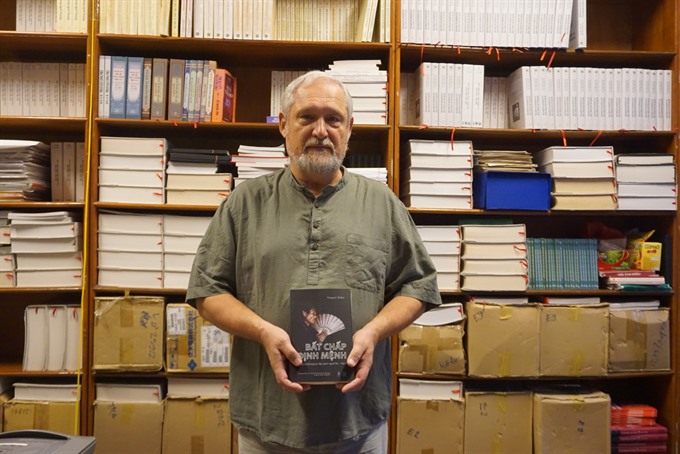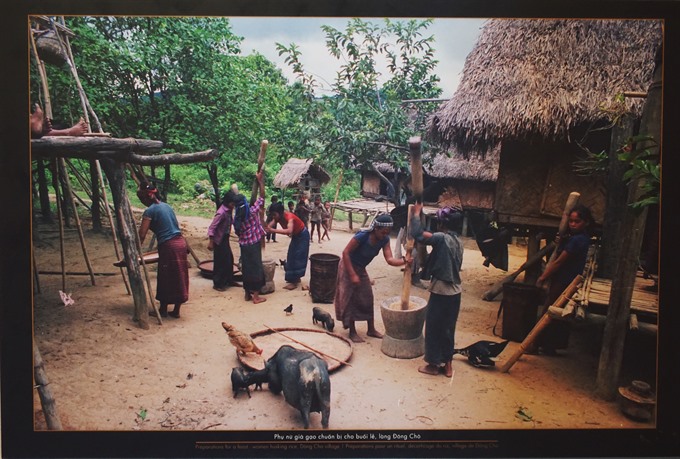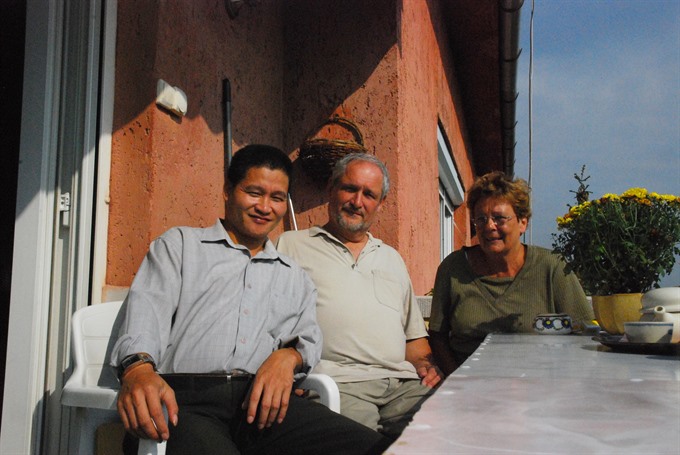Viet Nam News
by Hong Van
Gabor Vargyas was the first foreign anthropologist to study the Bru Van Kieu people in the central region of Viet Nam in depth.
The Hungarian spent a total of 18 months from 1985 to 1989 observing and partipating in their culture, which meant, working, eating and living with them.
In October, he returned Viet Nam to introduce first book in Vietnamese Bat Chap Dinh Menh: Van Hoa va Phong Tuc Tap Quan Nguoi Bru Van Kieu (Culture and Customs of the Bru Van Kieu) and opened his exhibition ‘Divinities, Ancestors and Shamans: The Bru - Van Kieu in The Truong Son Range’ at the Museum of Ethnology.
The Bru Van Kieu group is one of Viet Nam’s 54 ethnic minorities and has a population of around 80,000 people. They live along the border with Laos in the central provinces of Quang Binh and Quang Tri and the Central Highlands province of Dak Lak.
“We do science for the great public and for public use. If I can help the Bru to become more known and better understood by the majority – the Kinh majority, then I will be really happy because I think the Kinh majority doesn’t truly know the real life of ethnic minorities in Viet Nam. If I can contribute to a better understanding of the Bru Van Kieu by the Vietnamese majority then I consider I did a good job,” said Varyas.
 |
| Debut: Bat Chap Dinh Menh: Van Hoa va Phong Tuc Tap Quan Nguoi Bru Van Kieu was his first book translated into Vietnamese. — VNS Photo Hong Van |
Vargyas chose Bru Van Kieu as they were “completely unknown” at that time.
“Bru Van Kieu are in the centre of my research. And thanks to them, I could make some contributions to anthropology, to science, and that makes me very happy,” said Vargyas.
As he knows Bru culture from the inside, when he visited other minorities in Viet Nam and abroad, he understood many things in their culture because they were similar.
“To read books and know about Viet Nam and to know it personally are totally different things. It’s the same with the minorities. You may read about Mnong, E de, you may see photographs of them but if you don’t go there, if you don’t know their language, you will never know them really,” said Vargyas.
For Vargyas, despite the inconvenient living circumstances without electricity, familiar food or shops, he enjoyed the land and people there greatly.
“Maybe the conditions were not comfortable but I felt totally at home. These people are extremely intelligent, helpful, kind and hospitable. They always did their best in order to accommodate me and my colleagues. So I felt myself totally as in Hungarian villages where I did also go very often in those days.
“Hungarian villages are also backwards as compared to cities. But I never felt that this is dangerous or hard. It was a bit different but this difference is precisely that is interesting to me. I wanted to know how they lived in such circumstances and this was why I went there,” Vargyas told Viet Nam News.
The true hardship for him, however, was that they do not use chairs.
“They sit on the floor, cross-legged for hours. This is truly hard for somebody as me who is not used to that. On the other hand, there was no loudspeaker, no noise of motorbikes or pollution like in cities. It was so much nicer and better. I prefer living in the forest in the so-called wild environment,” he added.
 |
| Celebration: A photograph showing women husking rice to prepare for a feast by Vargyas. — VNS Photo Hong Van |
‘Beautiful’ moments
Recalling his time in Viet Nam, he said he had thousands of memories including speaking a little of the Bru language.
“I remember how I learned the word ‘beautiful’. Once, I went with a local guy to the forest for hunting. We climbed to a mountain and saw a beautiful panorama. He sat down there, looked around with a smile and told me:‘Isn’t it beautiful?’
“I understood that he couldn’t say anything else but that word because obviously the context didn’t permit anything else and that’s how you learn a language. You are with them, you see what’s happening, you understand the context and then you learn the language,” said Vargyas.
“And we were there, contemplating nature, and I understood that he loved his homeland just as we love our home. If you are a Vietnamese born in the plain, in a small village, being familiar with the bamboo baskets, the communal houses,and the rice fields, this is forever beautiful for you. For them the mountain landscape was just as beautiful and their pride. This is one of my very first memories, and it is beautiful,” said Vargyas.
 |
| Little help from my friends: Dinh Hong Hai was a research assistant for Vargyas during his field trip in Dak Lak Province to conduct a study on the Bru in 2007. — Photo courtesy of Hai |
Excellent works
Vargyas opened exhibitions about the Bru in Hungary and Serbia and has held lectures and discussions about the ethnic group in conferences in countries including Hungary, Georgia, Hong Kong (China) and Viet Nam.
“I found the exhibit very interesting, especially Professor Gabor’s presentation on the afterlife and divinities. The pictures of the spiritual and realistic actions are fantastic. The whole thing is amazing, very well done,” American professor in education Fred Kapp said about the exhibition in Viet Nam.
Currently he works as a professor in anthropology and head of the doctoral programme at University of Pecs in Hungary with hundreds of scientific papers and books published in English, German, French and Hungarian over the past 30 years.
Bat Chap Dinh Menh: Van Hoa va Phong Tuc Tap Quan Nguoi Bru Van Kieu was his first book translated into Vietnamese.
“We never write for ourselves, we write for others to bridge the gap between different cultures and languages. So the ethnographers are a kind of a communicator who make bridges between two different ethnic groups, between the Bru Van Kieu and the Vietnamese, or the Hungarians and the Vietnamese. So that’s why I consider it very important that my book is now translated into Vietnamese,” said Vargyas.
Associate professor Dinh Hong Hai from the National University of Viet Nam’s School of Social Sciences and Humanities said “This is one of the most prominent research works on Bru people in particular and Viet Nam’s ethnic minorities in general. His excellent working method and the acute scientific statements in this book give us valuable lessons and a huge amount of information and knowledge.”
“In the context of rapid development and urbanisation, such remarkable research works are truly a heritage for not only scientists and scholars but everyone,” Hai told Viet Nam News. — VNS